Career Development Plan Report: Cox & Kings Leadership Analysis
VerifiedAdded on 2020/01/21
|16
|4951
|134
Report
AI Summary
This report presents a comprehensive career development plan, focusing on the analysis of management styles, leadership characteristics, and organizational culture within Cox & Kings. The report begins by comparing different management styles, discussing the leadership qualities of senior managers, and evaluating the communication processes within the organization. It then assesses management skills, personal strengths, weaknesses, opportunities, and threats, setting objectives and targets for potential development. The report also explores the importance of leading and motivating a team, justifying managerial decisions, and detailing how managerial and personal skills support career advancement and set agendas for the future. The conclusion summarizes the key findings and provides recommendations for future career development, emphasizing the importance of continuous improvement and adaptability in the dynamic business environment.
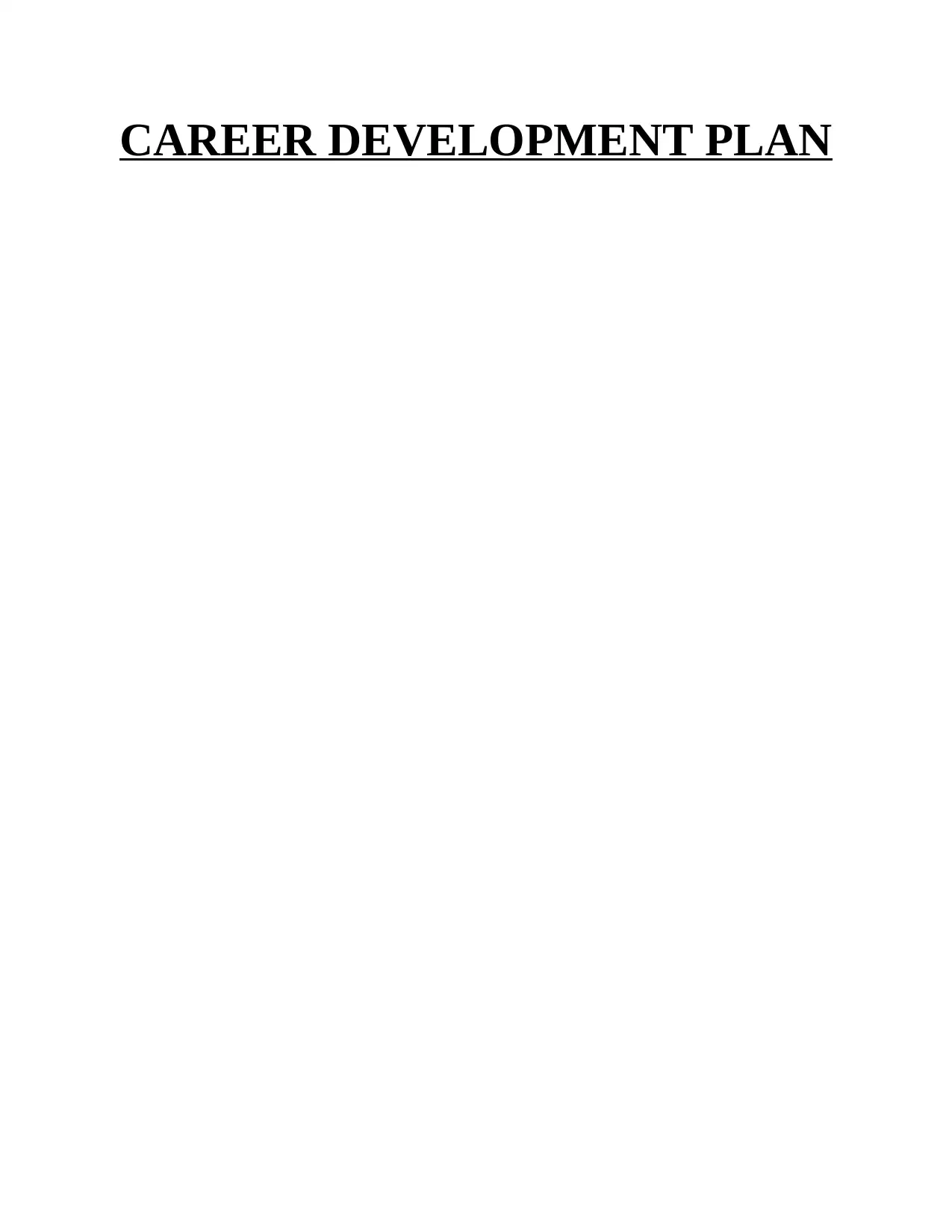
CAREER DEVELOPMENT PLAN
Paraphrase This Document
Need a fresh take? Get an instant paraphrase of this document with our AI Paraphraser
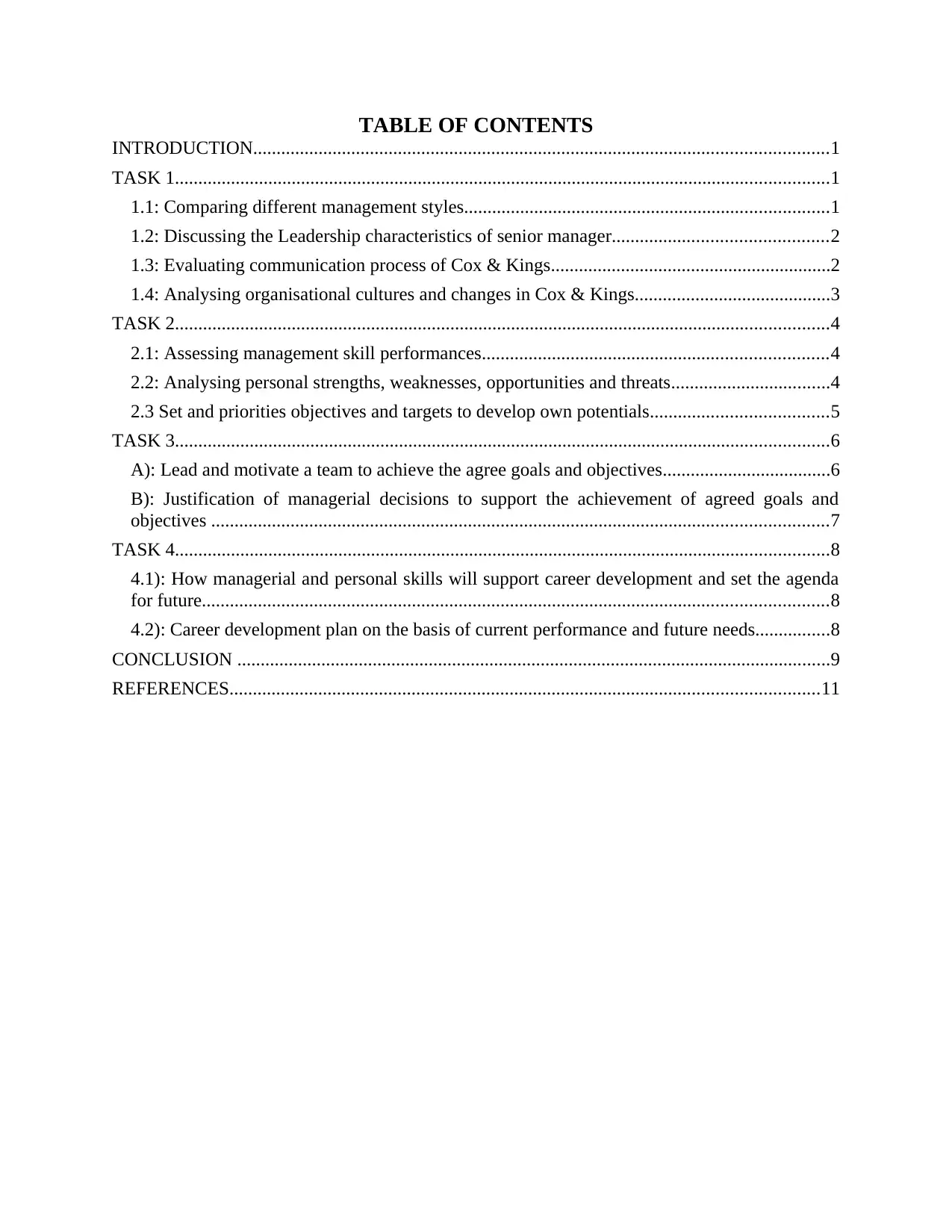
TABLE OF CONTENTS
INTRODUCTION...........................................................................................................................1
TASK 1............................................................................................................................................1
1.1: Comparing different management styles..............................................................................1
1.2: Discussing the Leadership characteristics of senior manager..............................................2
1.3: Evaluating communication process of Cox & Kings............................................................2
1.4: Analysing organisational cultures and changes in Cox & Kings..........................................3
TASK 2............................................................................................................................................4
2.1: Assessing management skill performances..........................................................................4
2.2: Analysing personal strengths, weaknesses, opportunities and threats..................................4
2.3 Set and priorities objectives and targets to develop own potentials......................................5
TASK 3............................................................................................................................................6
A): Lead and motivate a team to achieve the agree goals and objectives....................................6
B): Justification of managerial decisions to support the achievement of agreed goals and
objectives ....................................................................................................................................7
TASK 4............................................................................................................................................8
4.1): How managerial and personal skills will support career development and set the agenda
for future......................................................................................................................................8
4.2): Career development plan on the basis of current performance and future needs................8
CONCLUSION ...............................................................................................................................9
REFERENCES..............................................................................................................................11
INTRODUCTION...........................................................................................................................1
TASK 1............................................................................................................................................1
1.1: Comparing different management styles..............................................................................1
1.2: Discussing the Leadership characteristics of senior manager..............................................2
1.3: Evaluating communication process of Cox & Kings............................................................2
1.4: Analysing organisational cultures and changes in Cox & Kings..........................................3
TASK 2............................................................................................................................................4
2.1: Assessing management skill performances..........................................................................4
2.2: Analysing personal strengths, weaknesses, opportunities and threats..................................4
2.3 Set and priorities objectives and targets to develop own potentials......................................5
TASK 3............................................................................................................................................6
A): Lead and motivate a team to achieve the agree goals and objectives....................................6
B): Justification of managerial decisions to support the achievement of agreed goals and
objectives ....................................................................................................................................7
TASK 4............................................................................................................................................8
4.1): How managerial and personal skills will support career development and set the agenda
for future......................................................................................................................................8
4.2): Career development plan on the basis of current performance and future needs................8
CONCLUSION ...............................................................................................................................9
REFERENCES..............................................................................................................................11
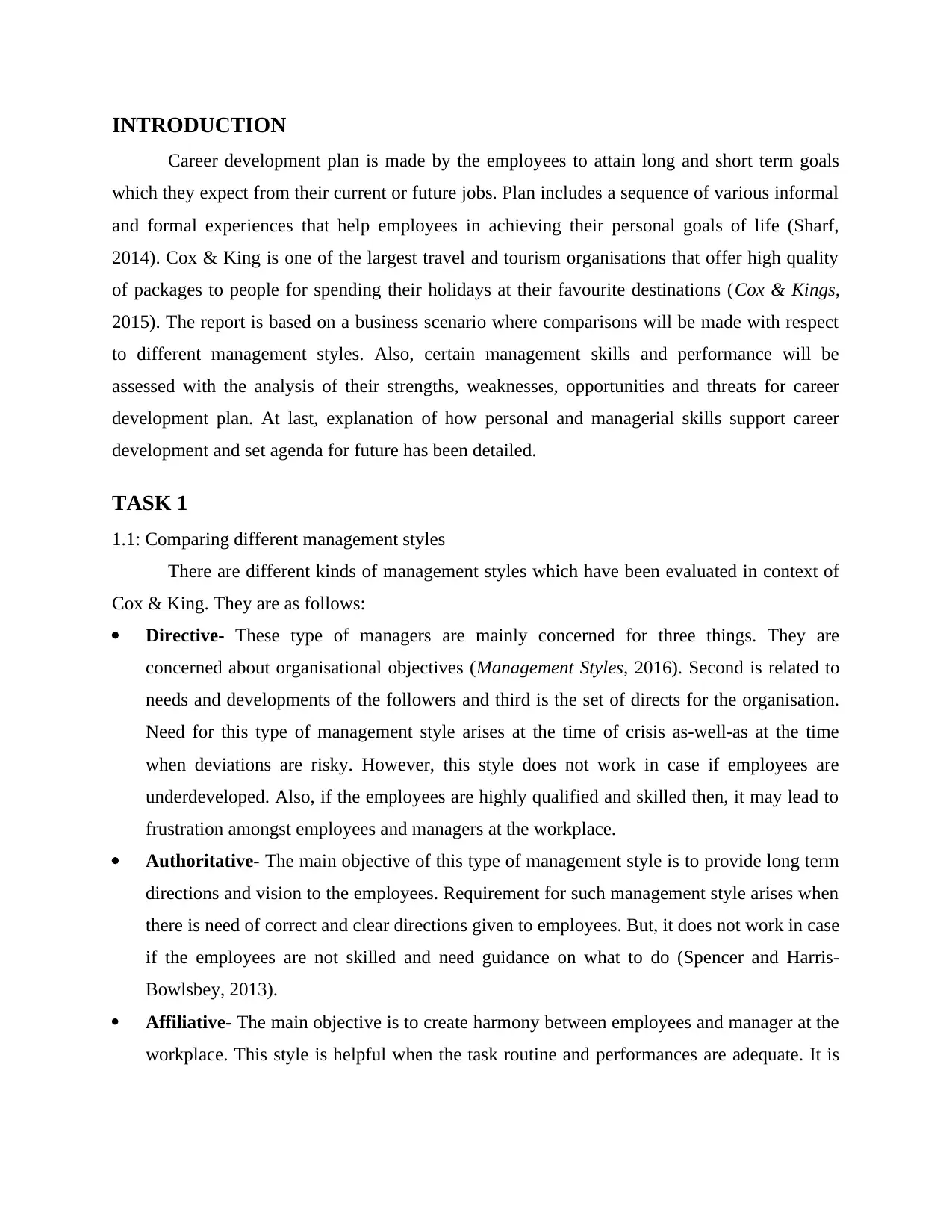
INTRODUCTION
Career development plan is made by the employees to attain long and short term goals
which they expect from their current or future jobs. Plan includes a sequence of various informal
and formal experiences that help employees in achieving their personal goals of life (Sharf,
2014). Cox & King is one of the largest travel and tourism organisations that offer high quality
of packages to people for spending their holidays at their favourite destinations (Cox & Kings,
2015). The report is based on a business scenario where comparisons will be made with respect
to different management styles. Also, certain management skills and performance will be
assessed with the analysis of their strengths, weaknesses, opportunities and threats for career
development plan. At last, explanation of how personal and managerial skills support career
development and set agenda for future has been detailed.
TASK 1
1.1: Comparing different management styles
There are different kinds of management styles which have been evaluated in context of
Cox & King. They are as follows:
Directive- These type of managers are mainly concerned for three things. They are
concerned about organisational objectives (Management Styles, 2016). Second is related to
needs and developments of the followers and third is the set of directs for the organisation.
Need for this type of management style arises at the time of crisis as-well-as at the time
when deviations are risky. However, this style does not work in case if employees are
underdeveloped. Also, if the employees are highly qualified and skilled then, it may lead to
frustration amongst employees and managers at the workplace.
Authoritative- The main objective of this type of management style is to provide long term
directions and vision to the employees. Requirement for such management style arises when
there is need of correct and clear directions given to employees. But, it does not work in case
if the employees are not skilled and need guidance on what to do (Spencer and Harris-
Bowlsbey, 2013).
Affiliative- The main objective is to create harmony between employees and manager at the
workplace. This style is helpful when the task routine and performances are adequate. It is
Career development plan is made by the employees to attain long and short term goals
which they expect from their current or future jobs. Plan includes a sequence of various informal
and formal experiences that help employees in achieving their personal goals of life (Sharf,
2014). Cox & King is one of the largest travel and tourism organisations that offer high quality
of packages to people for spending their holidays at their favourite destinations (Cox & Kings,
2015). The report is based on a business scenario where comparisons will be made with respect
to different management styles. Also, certain management skills and performance will be
assessed with the analysis of their strengths, weaknesses, opportunities and threats for career
development plan. At last, explanation of how personal and managerial skills support career
development and set agenda for future has been detailed.
TASK 1
1.1: Comparing different management styles
There are different kinds of management styles which have been evaluated in context of
Cox & King. They are as follows:
Directive- These type of managers are mainly concerned for three things. They are
concerned about organisational objectives (Management Styles, 2016). Second is related to
needs and developments of the followers and third is the set of directs for the organisation.
Need for this type of management style arises at the time of crisis as-well-as at the time
when deviations are risky. However, this style does not work in case if employees are
underdeveloped. Also, if the employees are highly qualified and skilled then, it may lead to
frustration amongst employees and managers at the workplace.
Authoritative- The main objective of this type of management style is to provide long term
directions and vision to the employees. Requirement for such management style arises when
there is need of correct and clear directions given to employees. But, it does not work in case
if the employees are not skilled and need guidance on what to do (Spencer and Harris-
Bowlsbey, 2013).
Affiliative- The main objective is to create harmony between employees and manager at the
workplace. This style is helpful when the task routine and performances are adequate. It is
⊘ This is a preview!⊘
Do you want full access?
Subscribe today to unlock all pages.

Trusted by 1+ million students worldwide
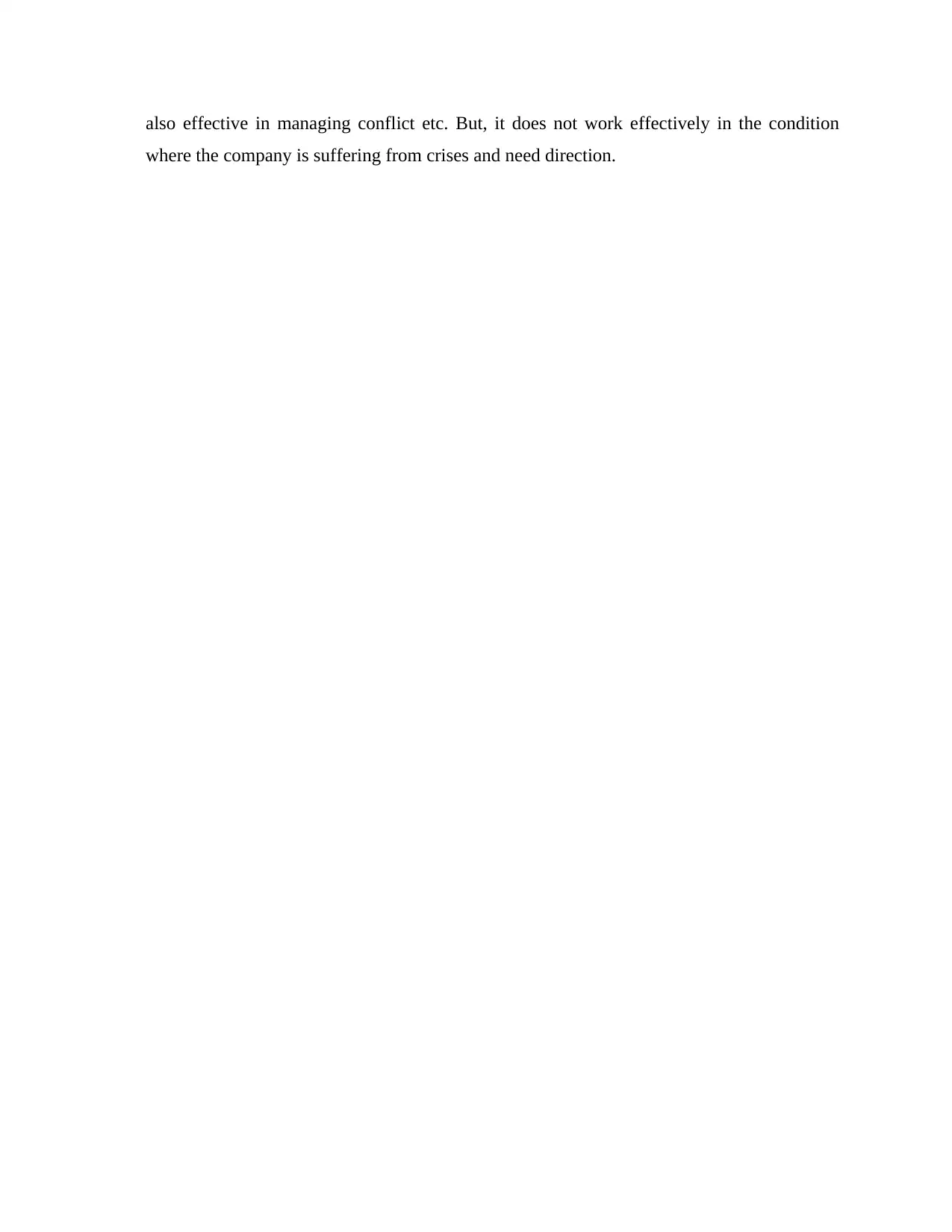
also effective in managing conflict etc. But, it does not work effectively in the condition
where the company is suffering from crises and need direction.
where the company is suffering from crises and need direction.
Paraphrase This Document
Need a fresh take? Get an instant paraphrase of this document with our AI Paraphraser
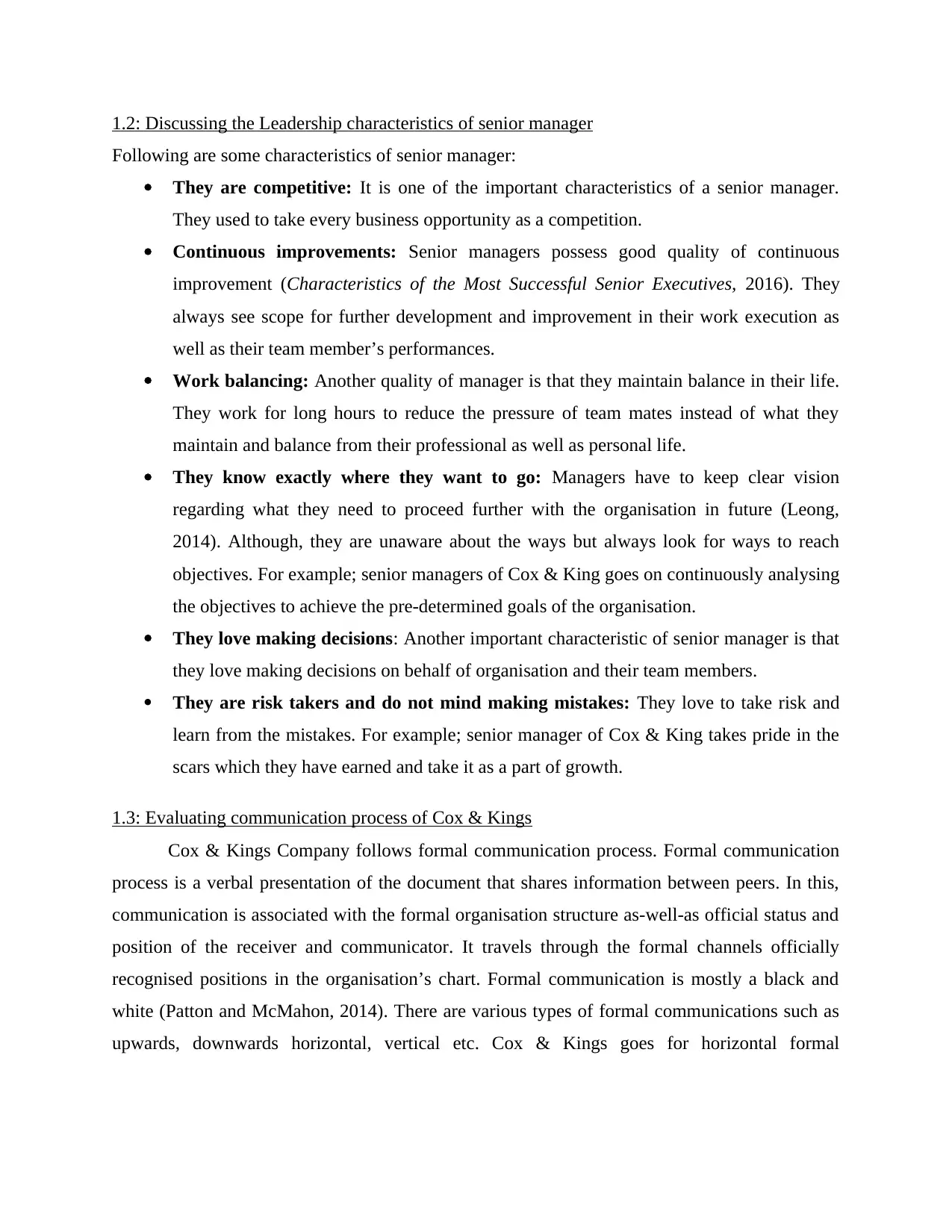
1.2: Discussing the Leadership characteristics of senior manager
Following are some characteristics of senior manager:
They are competitive: It is one of the important characteristics of a senior manager.
They used to take every business opportunity as a competition.
Continuous improvements: Senior managers possess good quality of continuous
improvement (Characteristics of the Most Successful Senior Executives, 2016). They
always see scope for further development and improvement in their work execution as
well as their team member’s performances.
Work balancing: Another quality of manager is that they maintain balance in their life.
They work for long hours to reduce the pressure of team mates instead of what they
maintain and balance from their professional as well as personal life.
They know exactly where they want to go: Managers have to keep clear vision
regarding what they need to proceed further with the organisation in future (Leong,
2014). Although, they are unaware about the ways but always look for ways to reach
objectives. For example; senior managers of Cox & King goes on continuously analysing
the objectives to achieve the pre-determined goals of the organisation.
They love making decisions: Another important characteristic of senior manager is that
they love making decisions on behalf of organisation and their team members.
They are risk takers and do not mind making mistakes: They love to take risk and
learn from the mistakes. For example; senior manager of Cox & King takes pride in the
scars which they have earned and take it as a part of growth.
1.3: Evaluating communication process of Cox & Kings
Cox & Kings Company follows formal communication process. Formal communication
process is a verbal presentation of the document that shares information between peers. In this,
communication is associated with the formal organisation structure as-well-as official status and
position of the receiver and communicator. It travels through the formal channels officially
recognised positions in the organisation’s chart. Formal communication is mostly a black and
white (Patton and McMahon, 2014). There are various types of formal communications such as
upwards, downwards horizontal, vertical etc. Cox & Kings goes for horizontal formal
Following are some characteristics of senior manager:
They are competitive: It is one of the important characteristics of a senior manager.
They used to take every business opportunity as a competition.
Continuous improvements: Senior managers possess good quality of continuous
improvement (Characteristics of the Most Successful Senior Executives, 2016). They
always see scope for further development and improvement in their work execution as
well as their team member’s performances.
Work balancing: Another quality of manager is that they maintain balance in their life.
They work for long hours to reduce the pressure of team mates instead of what they
maintain and balance from their professional as well as personal life.
They know exactly where they want to go: Managers have to keep clear vision
regarding what they need to proceed further with the organisation in future (Leong,
2014). Although, they are unaware about the ways but always look for ways to reach
objectives. For example; senior managers of Cox & King goes on continuously analysing
the objectives to achieve the pre-determined goals of the organisation.
They love making decisions: Another important characteristic of senior manager is that
they love making decisions on behalf of organisation and their team members.
They are risk takers and do not mind making mistakes: They love to take risk and
learn from the mistakes. For example; senior manager of Cox & King takes pride in the
scars which they have earned and take it as a part of growth.
1.3: Evaluating communication process of Cox & Kings
Cox & Kings Company follows formal communication process. Formal communication
process is a verbal presentation of the document that shares information between peers. In this,
communication is associated with the formal organisation structure as-well-as official status and
position of the receiver and communicator. It travels through the formal channels officially
recognised positions in the organisation’s chart. Formal communication is mostly a black and
white (Patton and McMahon, 2014). There are various types of formal communications such as
upwards, downwards horizontal, vertical etc. Cox & Kings goes for horizontal formal
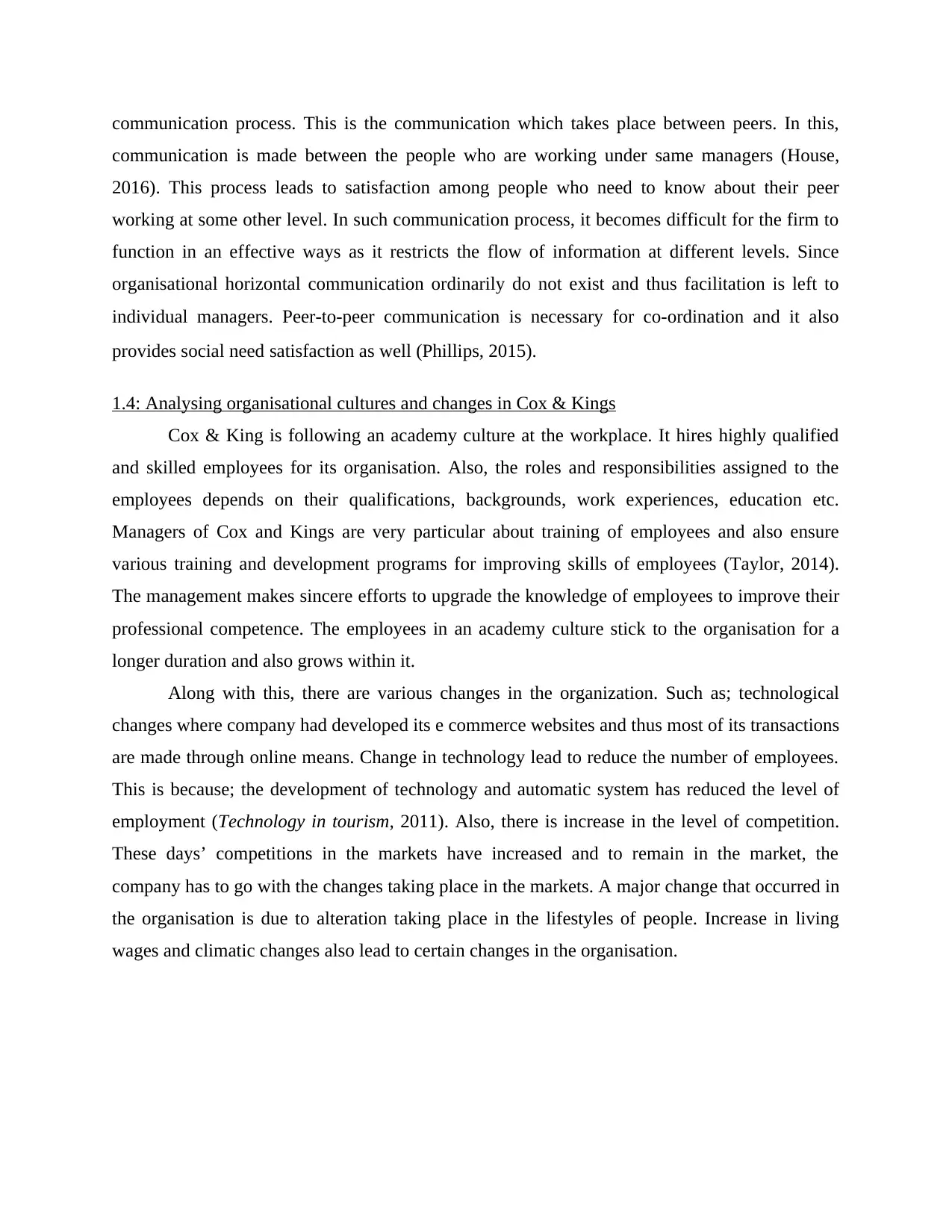
communication process. This is the communication which takes place between peers. In this,
communication is made between the people who are working under same managers (House,
2016). This process leads to satisfaction among people who need to know about their peer
working at some other level. In such communication process, it becomes difficult for the firm to
function in an effective ways as it restricts the flow of information at different levels. Since
organisational horizontal communication ordinarily do not exist and thus facilitation is left to
individual managers. Peer-to-peer communication is necessary for co-ordination and it also
provides social need satisfaction as well (Phillips, 2015).
1.4: Analysing organisational cultures and changes in Cox & Kings
Cox & King is following an academy culture at the workplace. It hires highly qualified
and skilled employees for its organisation. Also, the roles and responsibilities assigned to the
employees depends on their qualifications, backgrounds, work experiences, education etc.
Managers of Cox and Kings are very particular about training of employees and also ensure
various training and development programs for improving skills of employees (Taylor, 2014).
The management makes sincere efforts to upgrade the knowledge of employees to improve their
professional competence. The employees in an academy culture stick to the organisation for a
longer duration and also grows within it.
Along with this, there are various changes in the organization. Such as; technological
changes where company had developed its e commerce websites and thus most of its transactions
are made through online means. Change in technology lead to reduce the number of employees.
This is because; the development of technology and automatic system has reduced the level of
employment (Technology in tourism, 2011). Also, there is increase in the level of competition.
These days’ competitions in the markets have increased and to remain in the market, the
company has to go with the changes taking place in the markets. A major change that occurred in
the organisation is due to alteration taking place in the lifestyles of people. Increase in living
wages and climatic changes also lead to certain changes in the organisation.
communication is made between the people who are working under same managers (House,
2016). This process leads to satisfaction among people who need to know about their peer
working at some other level. In such communication process, it becomes difficult for the firm to
function in an effective ways as it restricts the flow of information at different levels. Since
organisational horizontal communication ordinarily do not exist and thus facilitation is left to
individual managers. Peer-to-peer communication is necessary for co-ordination and it also
provides social need satisfaction as well (Phillips, 2015).
1.4: Analysing organisational cultures and changes in Cox & Kings
Cox & King is following an academy culture at the workplace. It hires highly qualified
and skilled employees for its organisation. Also, the roles and responsibilities assigned to the
employees depends on their qualifications, backgrounds, work experiences, education etc.
Managers of Cox and Kings are very particular about training of employees and also ensure
various training and development programs for improving skills of employees (Taylor, 2014).
The management makes sincere efforts to upgrade the knowledge of employees to improve their
professional competence. The employees in an academy culture stick to the organisation for a
longer duration and also grows within it.
Along with this, there are various changes in the organization. Such as; technological
changes where company had developed its e commerce websites and thus most of its transactions
are made through online means. Change in technology lead to reduce the number of employees.
This is because; the development of technology and automatic system has reduced the level of
employment (Technology in tourism, 2011). Also, there is increase in the level of competition.
These days’ competitions in the markets have increased and to remain in the market, the
company has to go with the changes taking place in the markets. A major change that occurred in
the organisation is due to alteration taking place in the lifestyles of people. Increase in living
wages and climatic changes also lead to certain changes in the organisation.
⊘ This is a preview!⊘
Do you want full access?
Subscribe today to unlock all pages.

Trusted by 1+ million students worldwide
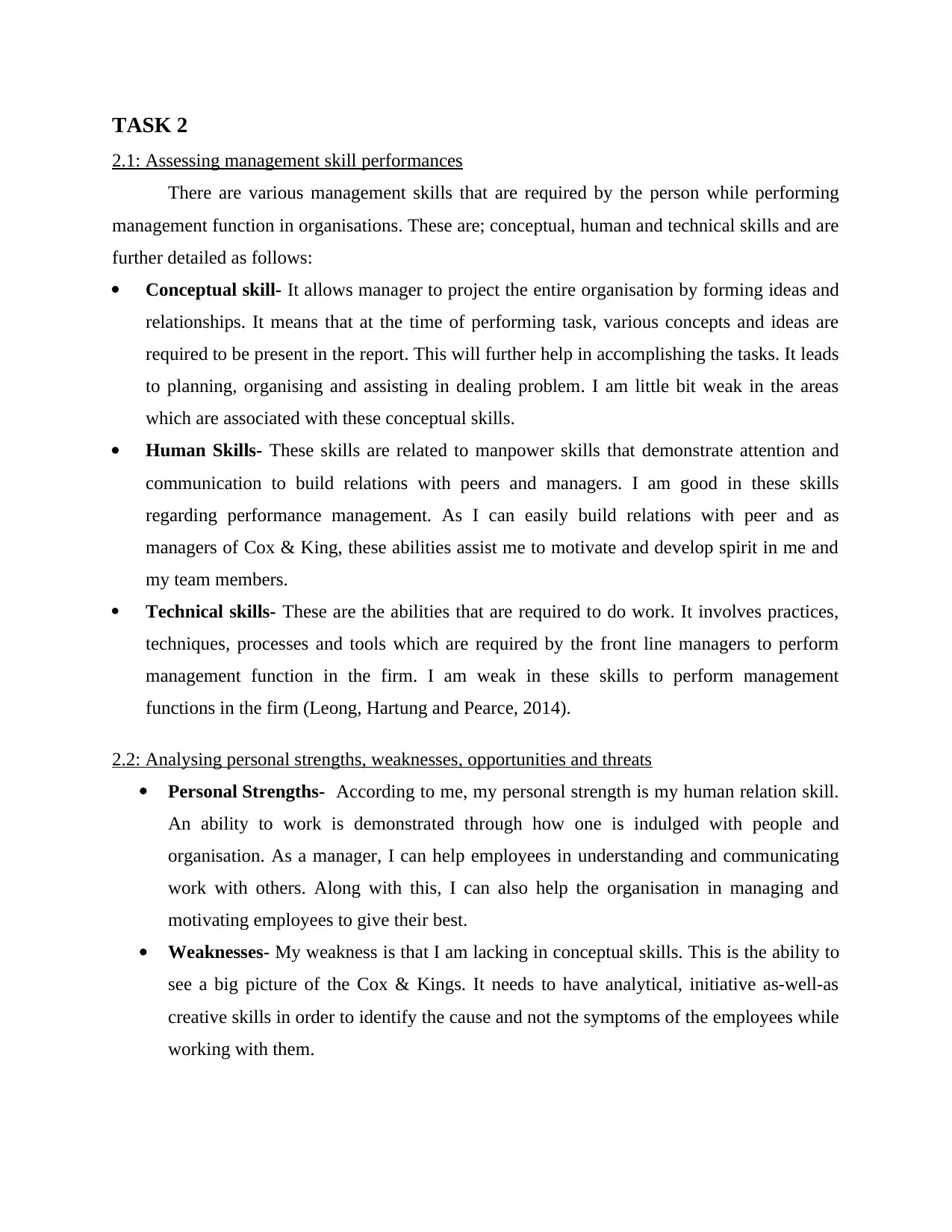
TASK 2
2.1: Assessing management skill performances
There are various management skills that are required by the person while performing
management function in organisations. These are; conceptual, human and technical skills and are
further detailed as follows:
Conceptual skill- It allows manager to project the entire organisation by forming ideas and
relationships. It means that at the time of performing task, various concepts and ideas are
required to be present in the report. This will further help in accomplishing the tasks. It leads
to planning, organising and assisting in dealing problem. I am little bit weak in the areas
which are associated with these conceptual skills.
Human Skills- These skills are related to manpower skills that demonstrate attention and
communication to build relations with peers and managers. I am good in these skills
regarding performance management. As I can easily build relations with peer and as
managers of Cox & King, these abilities assist me to motivate and develop spirit in me and
my team members.
Technical skills- These are the abilities that are required to do work. It involves practices,
techniques, processes and tools which are required by the front line managers to perform
management function in the firm. I am weak in these skills to perform management
functions in the firm (Leong, Hartung and Pearce, 2014).
2.2: Analysing personal strengths, weaknesses, opportunities and threats
Personal Strengths- According to me, my personal strength is my human relation skill.
An ability to work is demonstrated through how one is indulged with people and
organisation. As a manager, I can help employees in understanding and communicating
work with others. Along with this, I can also help the organisation in managing and
motivating employees to give their best.
Weaknesses- My weakness is that I am lacking in conceptual skills. This is the ability to
see a big picture of the Cox & Kings. It needs to have analytical, initiative as-well-as
creative skills in order to identify the cause and not the symptoms of the employees while
working with them.
2.1: Assessing management skill performances
There are various management skills that are required by the person while performing
management function in organisations. These are; conceptual, human and technical skills and are
further detailed as follows:
Conceptual skill- It allows manager to project the entire organisation by forming ideas and
relationships. It means that at the time of performing task, various concepts and ideas are
required to be present in the report. This will further help in accomplishing the tasks. It leads
to planning, organising and assisting in dealing problem. I am little bit weak in the areas
which are associated with these conceptual skills.
Human Skills- These skills are related to manpower skills that demonstrate attention and
communication to build relations with peers and managers. I am good in these skills
regarding performance management. As I can easily build relations with peer and as
managers of Cox & King, these abilities assist me to motivate and develop spirit in me and
my team members.
Technical skills- These are the abilities that are required to do work. It involves practices,
techniques, processes and tools which are required by the front line managers to perform
management function in the firm. I am weak in these skills to perform management
functions in the firm (Leong, Hartung and Pearce, 2014).
2.2: Analysing personal strengths, weaknesses, opportunities and threats
Personal Strengths- According to me, my personal strength is my human relation skill.
An ability to work is demonstrated through how one is indulged with people and
organisation. As a manager, I can help employees in understanding and communicating
work with others. Along with this, I can also help the organisation in managing and
motivating employees to give their best.
Weaknesses- My weakness is that I am lacking in conceptual skills. This is the ability to
see a big picture of the Cox & Kings. It needs to have analytical, initiative as-well-as
creative skills in order to identify the cause and not the symptoms of the employees while
working with them.
Paraphrase This Document
Need a fresh take? Get an instant paraphrase of this document with our AI Paraphraser
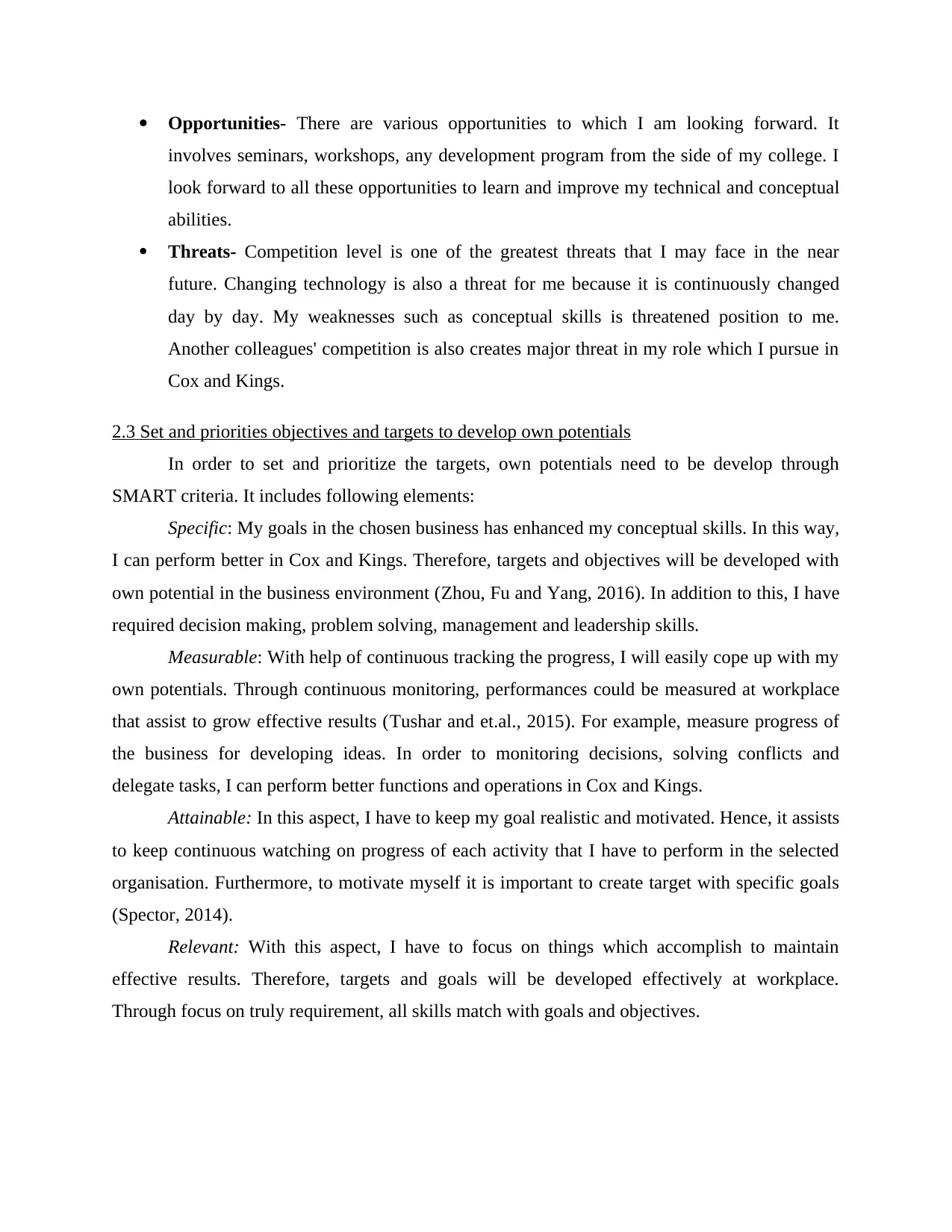
Opportunities- There are various opportunities to which I am looking forward. It
involves seminars, workshops, any development program from the side of my college. I
look forward to all these opportunities to learn and improve my technical and conceptual
abilities.
Threats- Competition level is one of the greatest threats that I may face in the near
future. Changing technology is also a threat for me because it is continuously changed
day by day. My weaknesses such as conceptual skills is threatened position to me.
Another colleagues' competition is also creates major threat in my role which I pursue in
Cox and Kings.
2.3 Set and priorities objectives and targets to develop own potentials
In order to set and prioritize the targets, own potentials need to be develop through
SMART criteria. It includes following elements:
Specific: My goals in the chosen business has enhanced my conceptual skills. In this way,
I can perform better in Cox and Kings. Therefore, targets and objectives will be developed with
own potential in the business environment (Zhou, Fu and Yang, 2016). In addition to this, I have
required decision making, problem solving, management and leadership skills.
Measurable: With help of continuous tracking the progress, I will easily cope up with my
own potentials. Through continuous monitoring, performances could be measured at workplace
that assist to grow effective results (Tushar and et.al., 2015). For example, measure progress of
the business for developing ideas. In order to monitoring decisions, solving conflicts and
delegate tasks, I can perform better functions and operations in Cox and Kings.
Attainable: In this aspect, I have to keep my goal realistic and motivated. Hence, it assists
to keep continuous watching on progress of each activity that I have to perform in the selected
organisation. Furthermore, to motivate myself it is important to create target with specific goals
(Spector, 2014).
Relevant: With this aspect, I have to focus on things which accomplish to maintain
effective results. Therefore, targets and goals will be developed effectively at workplace.
Through focus on truly requirement, all skills match with goals and objectives.
involves seminars, workshops, any development program from the side of my college. I
look forward to all these opportunities to learn and improve my technical and conceptual
abilities.
Threats- Competition level is one of the greatest threats that I may face in the near
future. Changing technology is also a threat for me because it is continuously changed
day by day. My weaknesses such as conceptual skills is threatened position to me.
Another colleagues' competition is also creates major threat in my role which I pursue in
Cox and Kings.
2.3 Set and priorities objectives and targets to develop own potentials
In order to set and prioritize the targets, own potentials need to be develop through
SMART criteria. It includes following elements:
Specific: My goals in the chosen business has enhanced my conceptual skills. In this way,
I can perform better in Cox and Kings. Therefore, targets and objectives will be developed with
own potential in the business environment (Zhou, Fu and Yang, 2016). In addition to this, I have
required decision making, problem solving, management and leadership skills.
Measurable: With help of continuous tracking the progress, I will easily cope up with my
own potentials. Through continuous monitoring, performances could be measured at workplace
that assist to grow effective results (Tushar and et.al., 2015). For example, measure progress of
the business for developing ideas. In order to monitoring decisions, solving conflicts and
delegate tasks, I can perform better functions and operations in Cox and Kings.
Attainable: In this aspect, I have to keep my goal realistic and motivated. Hence, it assists
to keep continuous watching on progress of each activity that I have to perform in the selected
organisation. Furthermore, to motivate myself it is important to create target with specific goals
(Spector, 2014).
Relevant: With this aspect, I have to focus on things which accomplish to maintain
effective results. Therefore, targets and goals will be developed effectively at workplace.
Through focus on truly requirement, all skills match with goals and objectives.
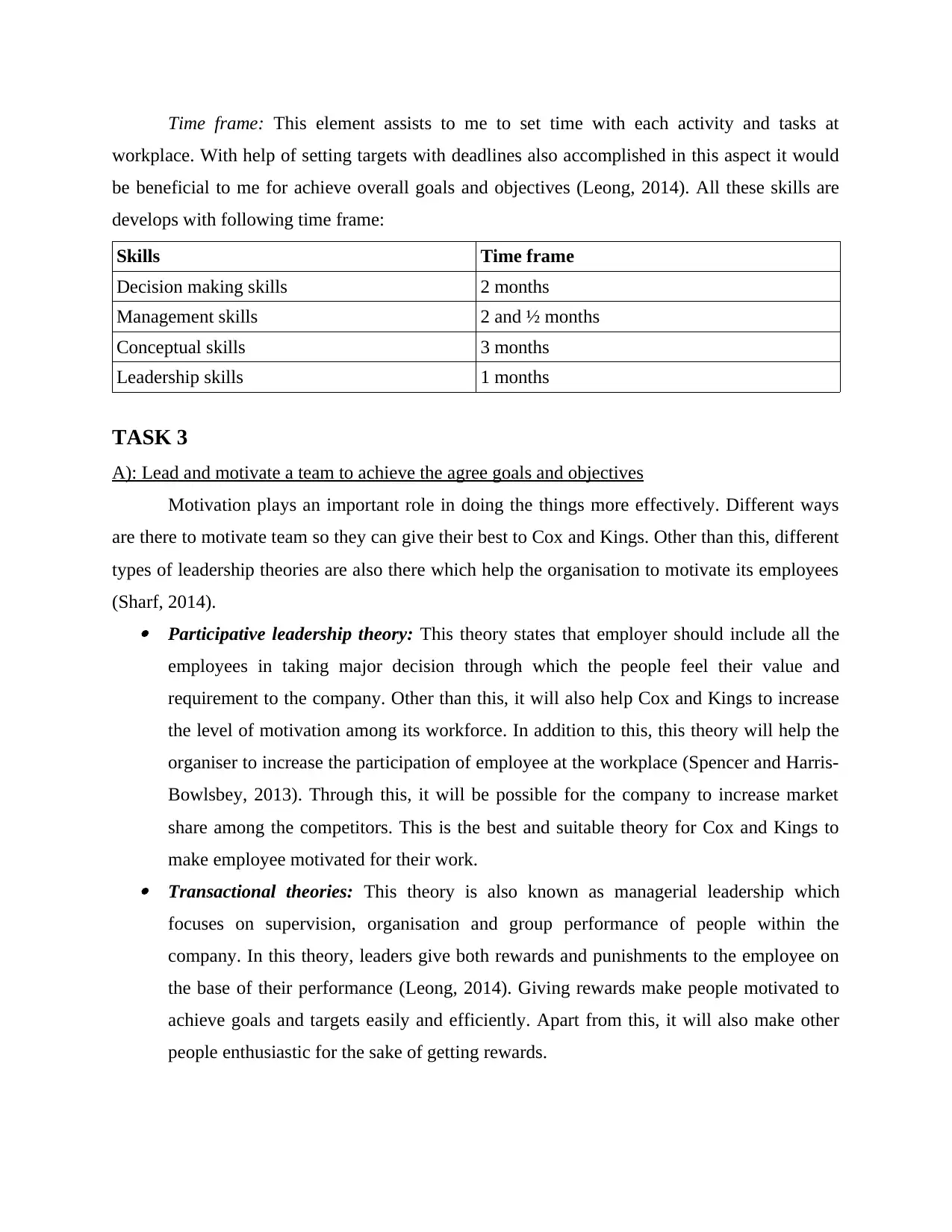
Time frame: This element assists to me to set time with each activity and tasks at
workplace. With help of setting targets with deadlines also accomplished in this aspect it would
be beneficial to me for achieve overall goals and objectives (Leong, 2014). All these skills are
develops with following time frame:
Skills Time frame
Decision making skills 2 months
Management skills 2 and ½ months
Conceptual skills 3 months
Leadership skills 1 months
TASK 3
A): Lead and motivate a team to achieve the agree goals and objectives
Motivation plays an important role in doing the things more effectively. Different ways
are there to motivate team so they can give their best to Cox and Kings. Other than this, different
types of leadership theories are also there which help the organisation to motivate its employees
(Sharf, 2014). Participative leadership theory: This theory states that employer should include all the
employees in taking major decision through which the people feel their value and
requirement to the company. Other than this, it will also help Cox and Kings to increase
the level of motivation among its workforce. In addition to this, this theory will help the
organiser to increase the participation of employee at the workplace (Spencer and Harris-
Bowlsbey, 2013). Through this, it will be possible for the company to increase market
share among the competitors. This is the best and suitable theory for Cox and Kings to
make employee motivated for their work. Transactional theories: This theory is also known as managerial leadership which
focuses on supervision, organisation and group performance of people within the
company. In this theory, leaders give both rewards and punishments to the employee on
the base of their performance (Leong, 2014). Giving rewards make people motivated to
achieve goals and targets easily and efficiently. Apart from this, it will also make other
people enthusiastic for the sake of getting rewards.
workplace. With help of setting targets with deadlines also accomplished in this aspect it would
be beneficial to me for achieve overall goals and objectives (Leong, 2014). All these skills are
develops with following time frame:
Skills Time frame
Decision making skills 2 months
Management skills 2 and ½ months
Conceptual skills 3 months
Leadership skills 1 months
TASK 3
A): Lead and motivate a team to achieve the agree goals and objectives
Motivation plays an important role in doing the things more effectively. Different ways
are there to motivate team so they can give their best to Cox and Kings. Other than this, different
types of leadership theories are also there which help the organisation to motivate its employees
(Sharf, 2014). Participative leadership theory: This theory states that employer should include all the
employees in taking major decision through which the people feel their value and
requirement to the company. Other than this, it will also help Cox and Kings to increase
the level of motivation among its workforce. In addition to this, this theory will help the
organiser to increase the participation of employee at the workplace (Spencer and Harris-
Bowlsbey, 2013). Through this, it will be possible for the company to increase market
share among the competitors. This is the best and suitable theory for Cox and Kings to
make employee motivated for their work. Transactional theories: This theory is also known as managerial leadership which
focuses on supervision, organisation and group performance of people within the
company. In this theory, leaders give both rewards and punishments to the employee on
the base of their performance (Leong, 2014). Giving rewards make people motivated to
achieve goals and targets easily and efficiently. Apart from this, it will also make other
people enthusiastic for the sake of getting rewards.
⊘ This is a preview!⊘
Do you want full access?
Subscribe today to unlock all pages.

Trusted by 1+ million students worldwide
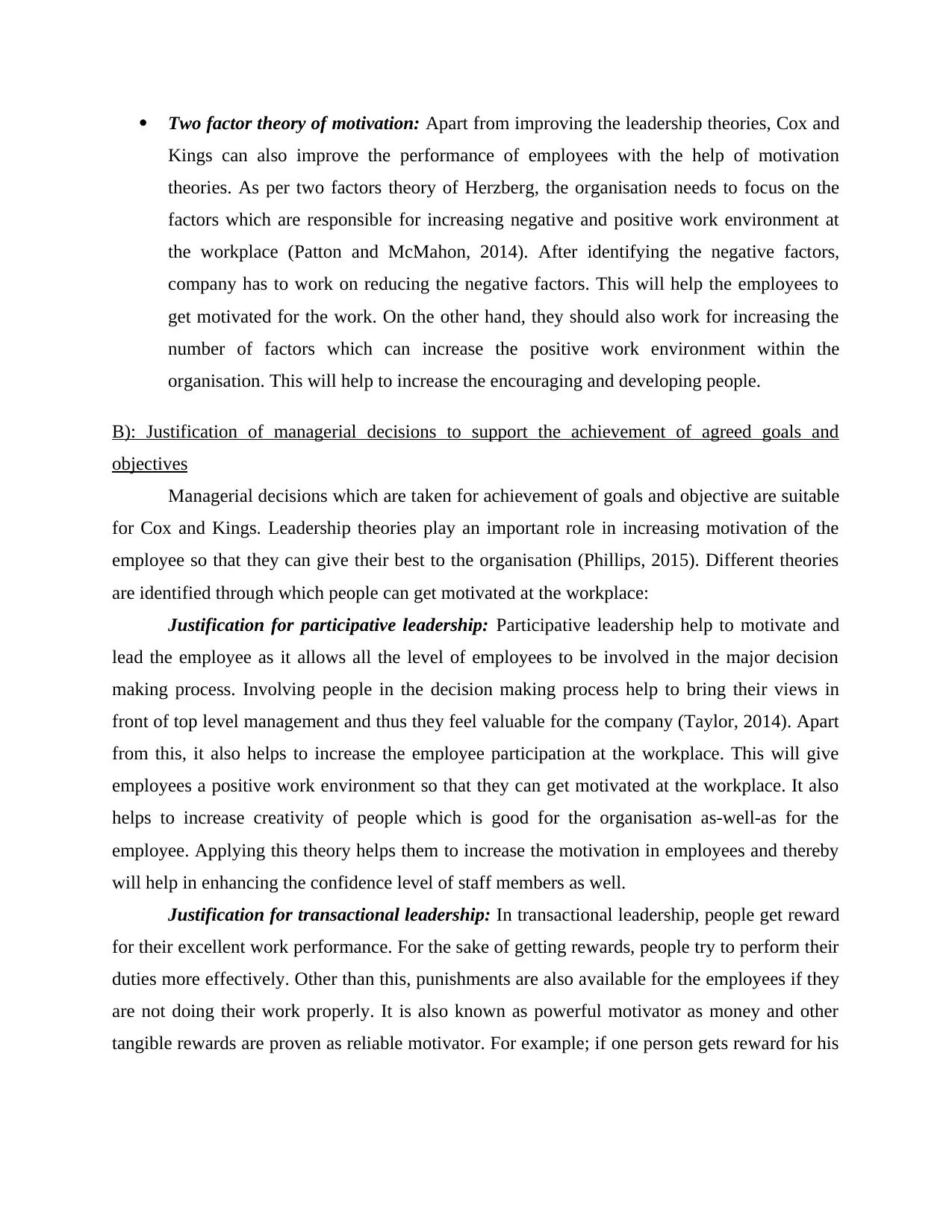
Two factor theory of motivation: Apart from improving the leadership theories, Cox and
Kings can also improve the performance of employees with the help of motivation
theories. As per two factors theory of Herzberg, the organisation needs to focus on the
factors which are responsible for increasing negative and positive work environment at
the workplace (Patton and McMahon, 2014). After identifying the negative factors,
company has to work on reducing the negative factors. This will help the employees to
get motivated for the work. On the other hand, they should also work for increasing the
number of factors which can increase the positive work environment within the
organisation. This will help to increase the encouraging and developing people.
B): Justification of managerial decisions to support the achievement of agreed goals and
objectives
Managerial decisions which are taken for achievement of goals and objective are suitable
for Cox and Kings. Leadership theories play an important role in increasing motivation of the
employee so that they can give their best to the organisation (Phillips, 2015). Different theories
are identified through which people can get motivated at the workplace:
Justification for participative leadership: Participative leadership help to motivate and
lead the employee as it allows all the level of employees to be involved in the major decision
making process. Involving people in the decision making process help to bring their views in
front of top level management and thus they feel valuable for the company (Taylor, 2014). Apart
from this, it also helps to increase the employee participation at the workplace. This will give
employees a positive work environment so that they can get motivated at the workplace. It also
helps to increase creativity of people which is good for the organisation as-well-as for the
employee. Applying this theory helps them to increase the motivation in employees and thereby
will help in enhancing the confidence level of staff members as well.
Justification for transactional leadership: In transactional leadership, people get reward
for their excellent work performance. For the sake of getting rewards, people try to perform their
duties more effectively. Other than this, punishments are also available for the employees if they
are not doing their work properly. It is also known as powerful motivator as money and other
tangible rewards are proven as reliable motivator. For example; if one person gets reward for his
Kings can also improve the performance of employees with the help of motivation
theories. As per two factors theory of Herzberg, the organisation needs to focus on the
factors which are responsible for increasing negative and positive work environment at
the workplace (Patton and McMahon, 2014). After identifying the negative factors,
company has to work on reducing the negative factors. This will help the employees to
get motivated for the work. On the other hand, they should also work for increasing the
number of factors which can increase the positive work environment within the
organisation. This will help to increase the encouraging and developing people.
B): Justification of managerial decisions to support the achievement of agreed goals and
objectives
Managerial decisions which are taken for achievement of goals and objective are suitable
for Cox and Kings. Leadership theories play an important role in increasing motivation of the
employee so that they can give their best to the organisation (Phillips, 2015). Different theories
are identified through which people can get motivated at the workplace:
Justification for participative leadership: Participative leadership help to motivate and
lead the employee as it allows all the level of employees to be involved in the major decision
making process. Involving people in the decision making process help to bring their views in
front of top level management and thus they feel valuable for the company (Taylor, 2014). Apart
from this, it also helps to increase the employee participation at the workplace. This will give
employees a positive work environment so that they can get motivated at the workplace. It also
helps to increase creativity of people which is good for the organisation as-well-as for the
employee. Applying this theory helps them to increase the motivation in employees and thereby
will help in enhancing the confidence level of staff members as well.
Justification for transactional leadership: In transactional leadership, people get reward
for their excellent work performance. For the sake of getting rewards, people try to perform their
duties more effectively. Other than this, punishments are also available for the employees if they
are not doing their work properly. It is also known as powerful motivator as money and other
tangible rewards are proven as reliable motivator. For example; if one person gets reward for his
Paraphrase This Document
Need a fresh take? Get an instant paraphrase of this document with our AI Paraphraser
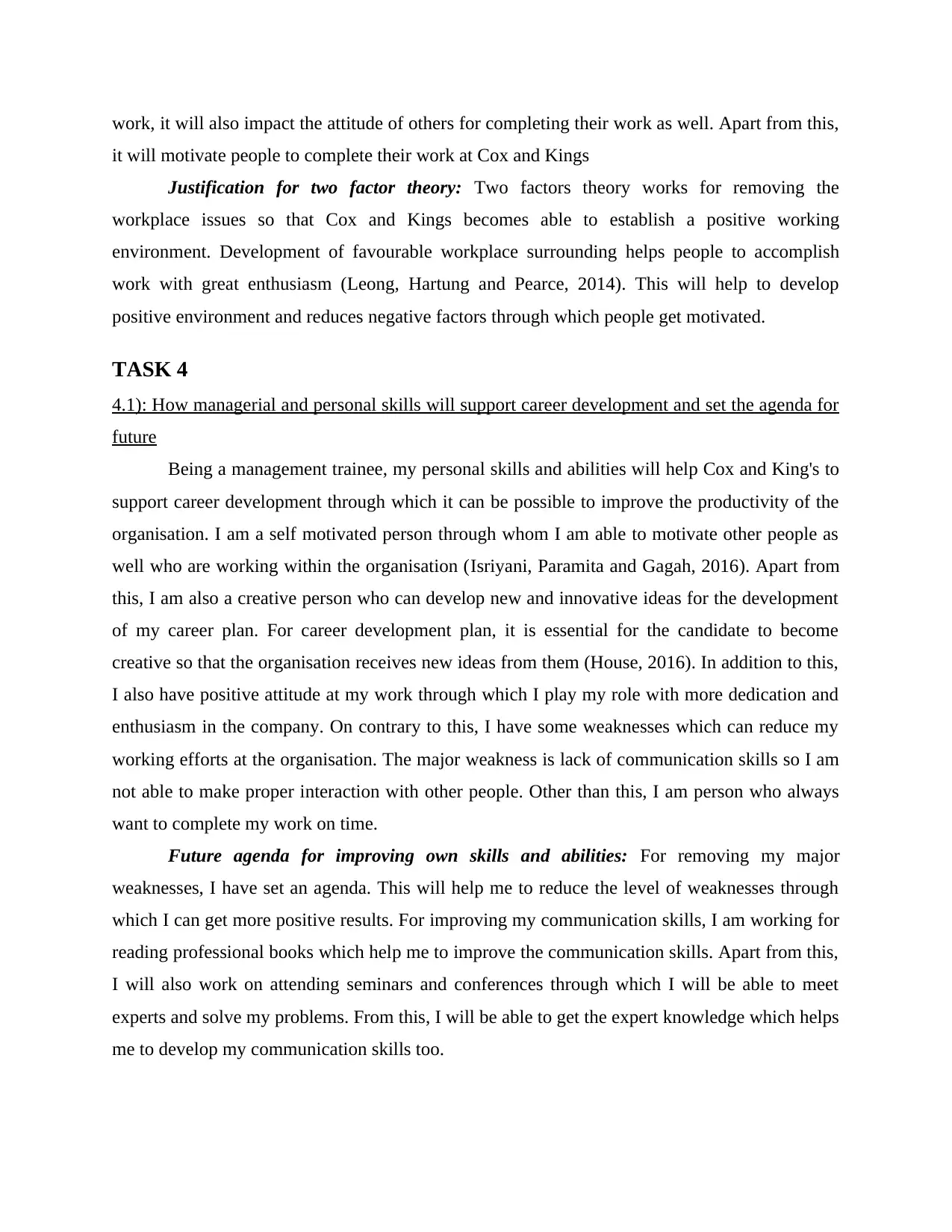
work, it will also impact the attitude of others for completing their work as well. Apart from this,
it will motivate people to complete their work at Cox and Kings
Justification for two factor theory: Two factors theory works for removing the
workplace issues so that Cox and Kings becomes able to establish a positive working
environment. Development of favourable workplace surrounding helps people to accomplish
work with great enthusiasm (Leong, Hartung and Pearce, 2014). This will help to develop
positive environment and reduces negative factors through which people get motivated.
TASK 4
4.1): How managerial and personal skills will support career development and set the agenda for
future
Being a management trainee, my personal skills and abilities will help Cox and King's to
support career development through which it can be possible to improve the productivity of the
organisation. I am a self motivated person through whom I am able to motivate other people as
well who are working within the organisation (Isriyani, Paramita and Gagah, 2016). Apart from
this, I am also a creative person who can develop new and innovative ideas for the development
of my career plan. For career development plan, it is essential for the candidate to become
creative so that the organisation receives new ideas from them (House, 2016). In addition to this,
I also have positive attitude at my work through which I play my role with more dedication and
enthusiasm in the company. On contrary to this, I have some weaknesses which can reduce my
working efforts at the organisation. The major weakness is lack of communication skills so I am
not able to make proper interaction with other people. Other than this, I am person who always
want to complete my work on time.
Future agenda for improving own skills and abilities: For removing my major
weaknesses, I have set an agenda. This will help me to reduce the level of weaknesses through
which I can get more positive results. For improving my communication skills, I am working for
reading professional books which help me to improve the communication skills. Apart from this,
I will also work on attending seminars and conferences through which I will be able to meet
experts and solve my problems. From this, I will be able to get the expert knowledge which helps
me to develop my communication skills too.
it will motivate people to complete their work at Cox and Kings
Justification for two factor theory: Two factors theory works for removing the
workplace issues so that Cox and Kings becomes able to establish a positive working
environment. Development of favourable workplace surrounding helps people to accomplish
work with great enthusiasm (Leong, Hartung and Pearce, 2014). This will help to develop
positive environment and reduces negative factors through which people get motivated.
TASK 4
4.1): How managerial and personal skills will support career development and set the agenda for
future
Being a management trainee, my personal skills and abilities will help Cox and King's to
support career development through which it can be possible to improve the productivity of the
organisation. I am a self motivated person through whom I am able to motivate other people as
well who are working within the organisation (Isriyani, Paramita and Gagah, 2016). Apart from
this, I am also a creative person who can develop new and innovative ideas for the development
of my career plan. For career development plan, it is essential for the candidate to become
creative so that the organisation receives new ideas from them (House, 2016). In addition to this,
I also have positive attitude at my work through which I play my role with more dedication and
enthusiasm in the company. On contrary to this, I have some weaknesses which can reduce my
working efforts at the organisation. The major weakness is lack of communication skills so I am
not able to make proper interaction with other people. Other than this, I am person who always
want to complete my work on time.
Future agenda for improving own skills and abilities: For removing my major
weaknesses, I have set an agenda. This will help me to reduce the level of weaknesses through
which I can get more positive results. For improving my communication skills, I am working for
reading professional books which help me to improve the communication skills. Apart from this,
I will also work on attending seminars and conferences through which I will be able to meet
experts and solve my problems. From this, I will be able to get the expert knowledge which helps
me to develop my communication skills too.
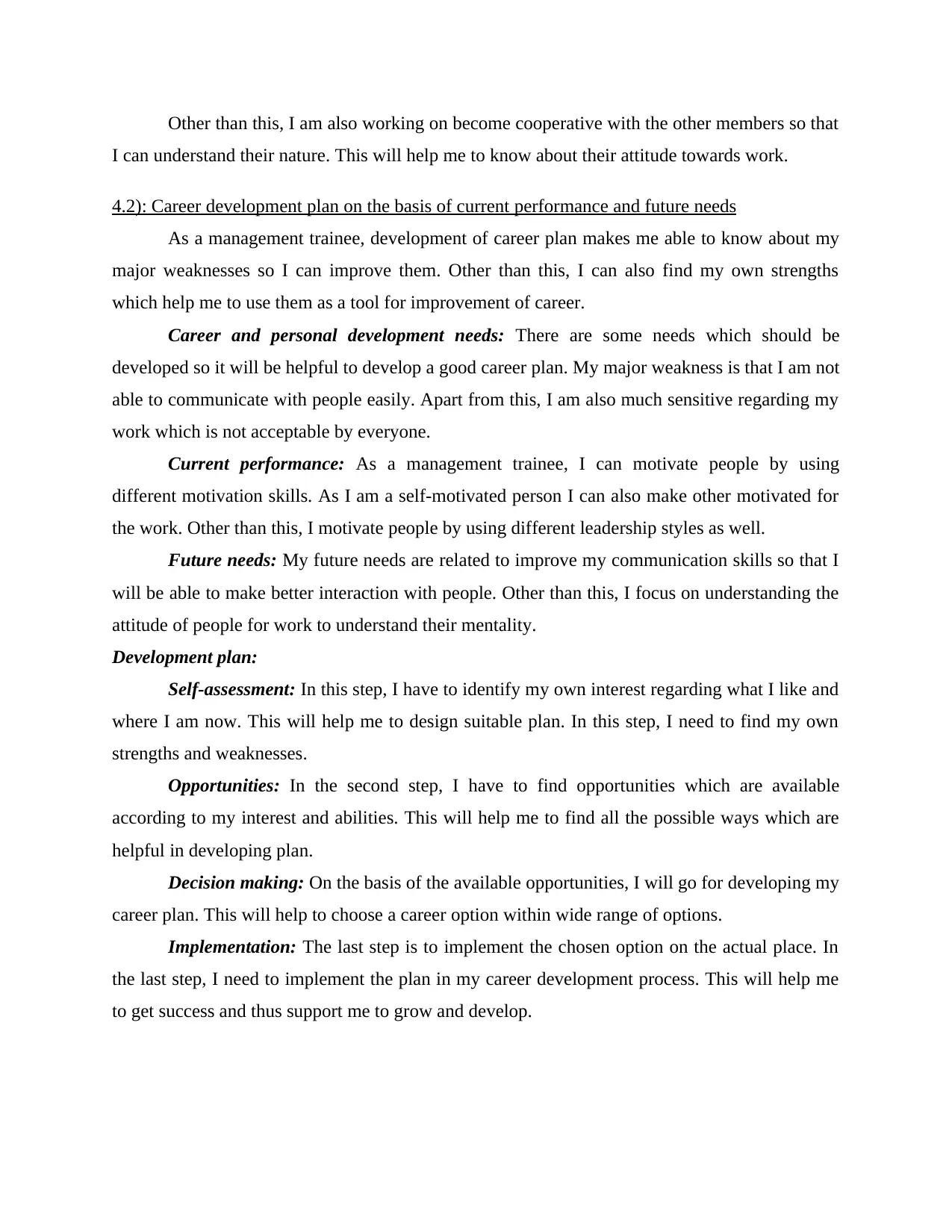
Other than this, I am also working on become cooperative with the other members so that
I can understand their nature. This will help me to know about their attitude towards work.
4.2): Career development plan on the basis of current performance and future needs
As a management trainee, development of career plan makes me able to know about my
major weaknesses so I can improve them. Other than this, I can also find my own strengths
which help me to use them as a tool for improvement of career.
Career and personal development needs: There are some needs which should be
developed so it will be helpful to develop a good career plan. My major weakness is that I am not
able to communicate with people easily. Apart from this, I am also much sensitive regarding my
work which is not acceptable by everyone.
Current performance: As a management trainee, I can motivate people by using
different motivation skills. As I am a self-motivated person I can also make other motivated for
the work. Other than this, I motivate people by using different leadership styles as well.
Future needs: My future needs are related to improve my communication skills so that I
will be able to make better interaction with people. Other than this, I focus on understanding the
attitude of people for work to understand their mentality.
Development plan:
Self-assessment: In this step, I have to identify my own interest regarding what I like and
where I am now. This will help me to design suitable plan. In this step, I need to find my own
strengths and weaknesses.
Opportunities: In the second step, I have to find opportunities which are available
according to my interest and abilities. This will help me to find all the possible ways which are
helpful in developing plan.
Decision making: On the basis of the available opportunities, I will go for developing my
career plan. This will help to choose a career option within wide range of options.
Implementation: The last step is to implement the chosen option on the actual place. In
the last step, I need to implement the plan in my career development process. This will help me
to get success and thus support me to grow and develop.
I can understand their nature. This will help me to know about their attitude towards work.
4.2): Career development plan on the basis of current performance and future needs
As a management trainee, development of career plan makes me able to know about my
major weaknesses so I can improve them. Other than this, I can also find my own strengths
which help me to use them as a tool for improvement of career.
Career and personal development needs: There are some needs which should be
developed so it will be helpful to develop a good career plan. My major weakness is that I am not
able to communicate with people easily. Apart from this, I am also much sensitive regarding my
work which is not acceptable by everyone.
Current performance: As a management trainee, I can motivate people by using
different motivation skills. As I am a self-motivated person I can also make other motivated for
the work. Other than this, I motivate people by using different leadership styles as well.
Future needs: My future needs are related to improve my communication skills so that I
will be able to make better interaction with people. Other than this, I focus on understanding the
attitude of people for work to understand their mentality.
Development plan:
Self-assessment: In this step, I have to identify my own interest regarding what I like and
where I am now. This will help me to design suitable plan. In this step, I need to find my own
strengths and weaknesses.
Opportunities: In the second step, I have to find opportunities which are available
according to my interest and abilities. This will help me to find all the possible ways which are
helpful in developing plan.
Decision making: On the basis of the available opportunities, I will go for developing my
career plan. This will help to choose a career option within wide range of options.
Implementation: The last step is to implement the chosen option on the actual place. In
the last step, I need to implement the plan in my career development process. This will help me
to get success and thus support me to grow and develop.
⊘ This is a preview!⊘
Do you want full access?
Subscribe today to unlock all pages.

Trusted by 1+ million students worldwide
1 out of 16
Related Documents
Your All-in-One AI-Powered Toolkit for Academic Success.
+13062052269
info@desklib.com
Available 24*7 on WhatsApp / Email
![[object Object]](/_next/static/media/star-bottom.7253800d.svg)
Unlock your academic potential
Copyright © 2020–2025 A2Z Services. All Rights Reserved. Developed and managed by ZUCOL.





